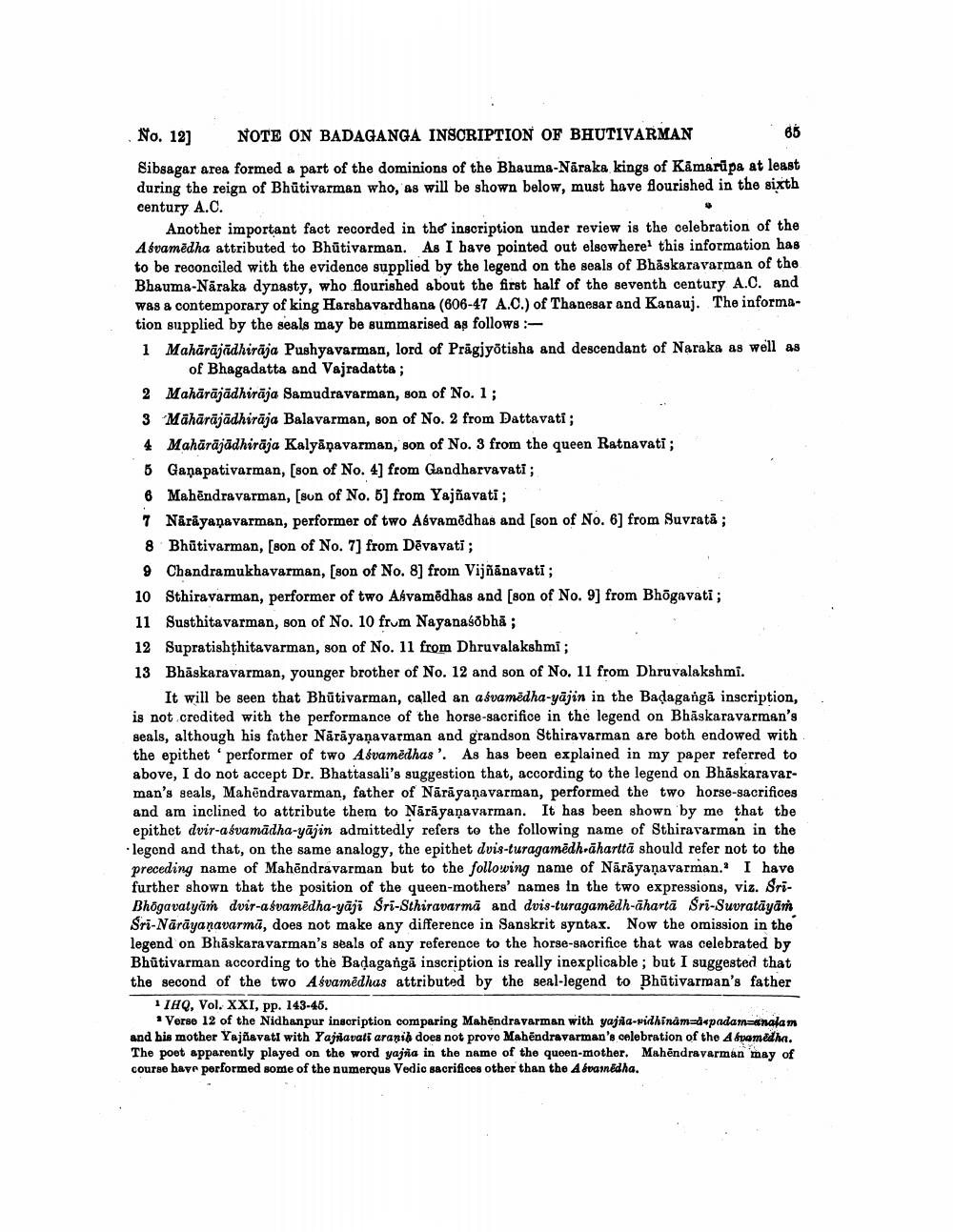________________
No. 12) NOTE ON BADAGANGA INSCRIPTION OF BHUTIVARMAN .86 Sibsagar area formed a part of the dominions of the Bhauma-Näraka kings of Kāmarūpa at least during the reign of Bhūtivarman who, as will be shown below, must have fourished in the sixth century A.O.
Another important fact recorded in the inscription under review is the celebration of the A svamēdha attributed to Bhūtivarman. As I have pointed out elsewhere. this information has to be reconciled with the evidence supplied by the legend on the seals of Bhāskaravarman of the Bhauma-Näraka dynasty, who flourished about the first half of the seventh century A.C. and was a contemporary of king Harshavardhana (606-47 A.C.) of Thanesar and Kanauj. The information supplied by the seals may be summarised as follows :1 Mahārājādhiraja Pushyavarman, lord of Prāgiyotisha and descendant of Naraka as well as
of Bhagadatta and Vajradatta; 2 Mahārājādhirāja Samudravarman, son of No. 1; 3 Mahārājādhirāja Balavarman, son of No. 2 from Dattavati ; 4 Mahārājadhiraja Kalyāṇavarman, son of No. 3 from the queen Ratnavati; 5 Ganapativarman, (son of No. 4] from Gandharvavati; 6 Mahēndravarman, [sun of No. 5) from Yajñavati; 7 Nārāyanavarman, performer of two Abvamēdhas and (son of No. 6] from Suvratā; 8 Bhūtivarman, (son of No. 7] from Dēvavati; 9 Chandramukhavarman, (son of No. 8] from Vijñānavati ; 10 Sthiravarman, performer of two Afvamēdhas and (son of No. 9] from Bhögavati; 11 Susthitavarman, son of No. 10 frum Nayanasobhā; 12 Supratishthitavarman, son of No. 11 from Dhruvalakshmi; 13 Bhāskaravarman, younger brother of No. 12 and son of No. 11 from Dhruvalakshmi.
It will be seen that Bhūtivarman, called an aśvamëdha-yājin in the Badagangā inscription, is not credited with the performance of the horse-sacrifice in the legend on Bhāskaravarman's seals, although his father Nārāyaṇavarman and grandson Sthiravarman are both endowed with the epithet 'performer of two Asvamēdhas'. As has been explained in my paper referred to above, I do not accept Dr. Bhattasali's suggestion that, according to the legend on Bhaskaravarman's seals, Mahindravarman, father of Nārāyaṇavarman, performed the two horse-sacrifices and am inclined to attribute them to Nārāyaṇavarman. It has been shown by me that the epithet dvir-asvamadha-yājin admittedly refers to the following name of Sthiravarman in the ·legend and that, on the same analogy, the epithet dvis-turagamēdh āharttā should refer not to the preceding name of Mahēndravarman but to the following name of Nārāyaṇavarman. I have further shown that the position of the queen-mothers' names in the two expressions, viz. SriBhögavatyā dvir-asvamēdha-yāji Sri-Sthiravarmā and dvis-turagamēdh-āhartā Sri-Suvratāyan Sri-Nārāyaṇavarmā, does not make any difference in Sanskrit syntax. Now the omission in the legend on Bhāskaravarman's seals of any reference to the horse-sacrifice that was celebrated by Bhūtivarman according to the Badaga ngā inscription is really inexplicable; but I suggested that the second of the two Asvamēdhas attributed by the seal-legend to Bhūtivarman's father
11HQ, Vol. XXI, pp. 143-45.
*Verse 12 of the Nidhanpur inscription comparing Mahendravarman with yajda-vidhinām=i<padam=analam and his mother Yajšavati with Yajnavati arapid does not prove Mahendravarman's celebration of the A bremedha. The poet apparently played on the word yajña in the name of the queen-mother. Mahēndravarman may of course have performed some of the numerous Vedic sacrifices other than the Advainēdha.




